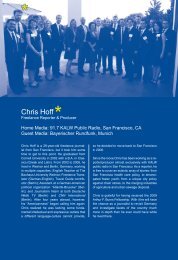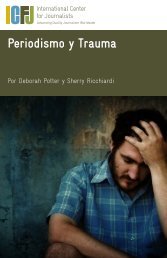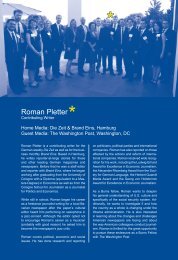Disaster and Crisis Coverage - International News Safety Institute
Disaster and Crisis Coverage - International News Safety Institute
Disaster and Crisis Coverage - International News Safety Institute
You also want an ePaper? Increase the reach of your titles
YUMPU automatically turns print PDFs into web optimized ePapers that Google loves.
✦<br />
✦<br />
✦<br />
✦<br />
✦<br />
✦<br />
✦<br />
✦<br />
Do not knowingly allow a live broadcast of a killing, whether homicide or<br />
suicide, especially in close-up <strong>and</strong> showing wounds <strong>and</strong> blood.<br />
Build in a delay of several seconds during live transmissions to allow<br />
managers to make a decision about whether to show something.<br />
Insist that photographers <strong>and</strong> photo <strong>and</strong> graphics editors join other news<br />
managers in deciding which photos to publish or videos to air. Don’t rely<br />
on one person’s opinion. Discuss it.<br />
Be sure relatives have been notified before announcing or showing the<br />
identity of a person who has been killed.<br />
Give viewers of television reports enough advance warning of what they<br />
are about to see so that someone can leave the room, remove children,<br />
or change the channel.<br />
Tell the whole story – before, during <strong>and</strong> after – of what happened to the<br />
human being involved, not just the death, no matter what photos or<br />
footage are used.<br />
Think about the effects of photos published on the front page <strong>and</strong> inside<br />
pages of a newspaper, as well as images in color versus black-<strong>and</strong>white.<br />
Something that might be too graphic for the front page could be<br />
less troublesome on an inside page, in black <strong>and</strong> white, or on the Web<br />
site.<br />
Discuss the decision, how it affected survivors <strong>and</strong> the public, <strong>and</strong><br />
whether the staff should have h<strong>and</strong>led it differently as soon as deadline<br />
pressures ease<br />
Case study: Photojournalist’s dilemma<br />
It was Monday around noon, after hurricane Katrina blew through New Orleans.<br />
There was word of flooding in the Lower Ninth Ward <strong>and</strong> Ted Jackson, a veteran<br />
photographer for the Times-Picayune, went to check it out. As he crossed a<br />
bridge, he spotted women <strong>and</strong> children str<strong>and</strong>ed on a porch, pleading for help as<br />
water rose around them.<br />
Yelling across the deep floodwaters that separated them, Jackson learned they<br />
had been clinging to porch railings for hours to keep from drowning. “I was trying<br />
to find some way to help them off that porch, <strong>and</strong> that definitely took priority over<br />
taking pictures,” he later recalled.<br />
The photographer faced a dilemma as he realized he had no way of getting to<br />
them. “I also knew that my editors – <strong>and</strong> the world – needed to see what was<br />
<strong>International</strong> Center for Journalists<br />
50
















